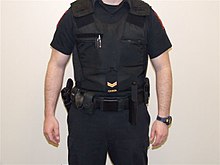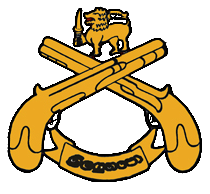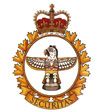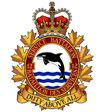Recent history
The Military Police in Halifax trace their roots back to World War I where, in 1917, the Canadian Military Police Corps (CMPC) was stood up and Number 6 Detachment was formed. Their main duty was to maintain discipline, enforce the Conscription Act, and apprehend deserters and draft evaders. The CMPC was stood down in 1920.
The Reserve MP Companies in the Canadian Army Primary Reserve trace their roots back to the Provost Companies formed during WWII although none of the Reserve Companies have their homes in the places that saw the birth of these wartime companies. The existing company in Halifax traces its roots back to Number 5 Provost Company, which was established after the conclusion of World War II. The company was headquartered in Halifax with detachments in Halifax and Moncton. In 1967 the Canadian Forces unified, causing the three service's policing elements to be brought together to form the Security Branch. As a result, the Provost Corps was disbanded and the existing Army Reserve Provost Platoons (Pl) in the Maritimes, which had grown to five, were each placed under the command of the new Service Battalions and titled Military Police Platoons (MP Pls). They were numbered 31, 32, 33, 36, and 37 MP Pls, which matched their Service Battalion numbers.
On 5 October 1997, under Reserve Restructure, Directive 7, and as a result of a number of studies concerning the Reserve MP Pls, they were removed from the Service Battalions and amalgamated into a single independent platoon in Halifax named 30 MP Pl. It was the first independent reserve MP unit in Canada and reported to the Commander of 36 Canadian Brigade Group (CBG). The platoon then moved from Willow Park to 12 Wing Shearwater.
In 2003, under the Army Reserve Establishment, 30 MP Pl became 30 MP Company (Coy) with the addition of a second Pl.
In September 2004, as a result of the second phase of the Land Force Reserve Restructure, Land Force Atlantic Area (LFAA) issued a Master Implementation Plan (MIP) for the stand up of 30 MP Coy as an Area direct report unit. This company was to consist of the existing 30 MP Pl from 36 CBG, the second Pl minus and Coy headquarters (HQ), all located in a leased facility in Lower Sackville, NS, and a third Pl created in Moncton, NB, from the reroll of a Pl from 4 Air Defence Regiment.
By 2005 it was recognized within the Army that Military Police units needed more independence in order to carry out their policing function while centralization of resources would enhance the MPs ability to force generate people for operations. Therefore, in February 2005, and on order of the Army Commander, LFAA issued a draft MIP for the stand up of 3 Garrison MP Coy. This Coy consists of the 3 ASG Gagetown MP Detachment (Det) and the 2nd Bn Royal Canadian Regiment MP Det. On 3 March 2005, the Army Commander signed and issued the Implementation Directive for centralization of garrison MP resources in each Land Force Area.
The creation of the garrison MP Coys was seen as an interim measures and, therefore, on 14 February 2006, the Army Commander signed the Implementation Directive for centralization of all Army MP resources at the Land Force Area level. This order authorized the creation of the MP Units in the four LFAs to be 1, 2, 3, and 5 MP Units. These units would consist of all Regular and Reserve Force Army MPs in each LFA. In LFAA this involved 3 Grn MP Coy (the garrison platoon in Gagetown), 30 MP Coy, the 2 RCR MP Det, and the Area Provost Marshal's Office.
In May 2006, LFAA issued its MIP for the formation and support of 3 MPU. Further, staffing of various full and part-time positions commenced. On 1 October 2006, the amalgamation of 30 MP Coy, 3 Grn MP Coy, and the HQ commenced. On 18 December 2006, the Minister of National Defence issued the Ministerial Organizational Order (MOO) authorizing the creation and stand-up of all MPUs, including 3 MPU. In September 2007, the unit's Canadian Forces Organizational Order was issued.
Further professionalization of the Canadian Military Police occurred when on 7 July 2010, the Chief of Defence Staff ordered that all Military Police would come under the full command of the Canadian Forces Provost Marshal, effective 1 April 2011. In March 2011 the Minister of National Defence authorized all the MPU's names to be changed to MP Regiments. As a result, on 1 April 2011, 3 MPU became 3 Military Police Regiment.
Announced officially in 2014, the old location of 3 Military Police Regiment HQ (at 70 First Lake Drive, Lower Sackville, NS B4C 3E4) moved to the new Maj Robert Campbell Risley Armoury (255 Damascus Rd., Bedford, NS, B4A 0C2).

















